人教九年级英语unit13We're trying to save the earth Grammar Focus(PPT共60张)
文档属性
| 名称 | 人教九年级英语unit13We're trying to save the earth Grammar Focus(PPT共60张) | 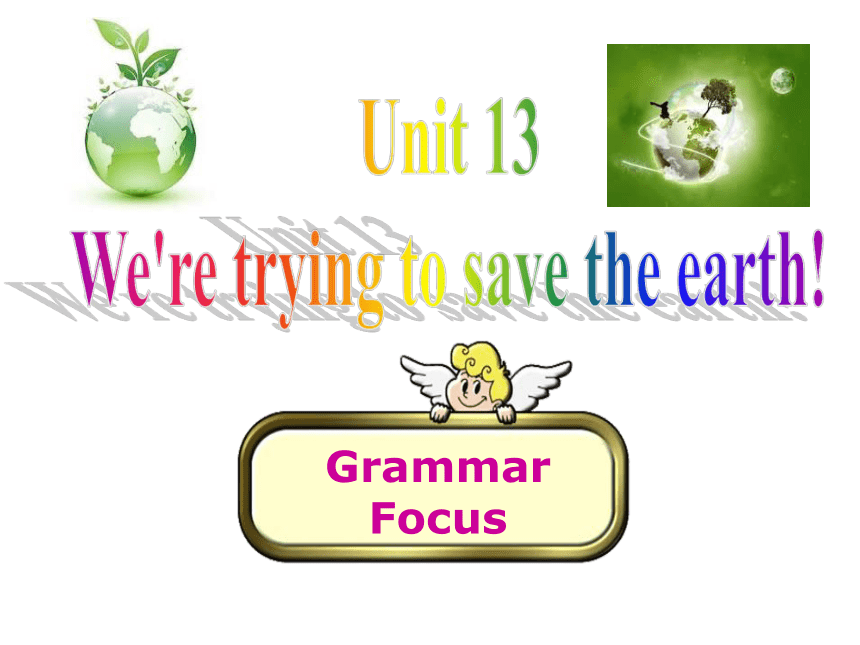 | |
| 格式 | zip | ||
| 文件大小 | 1.7MB | ||
| 资源类型 | 教案 | ||
| 版本资源 | 人教新目标(Go for it)版 | ||
| 科目 | 英语 | ||
| 更新时间 | 2020-11-19 23:15:07 | ||
图片预览


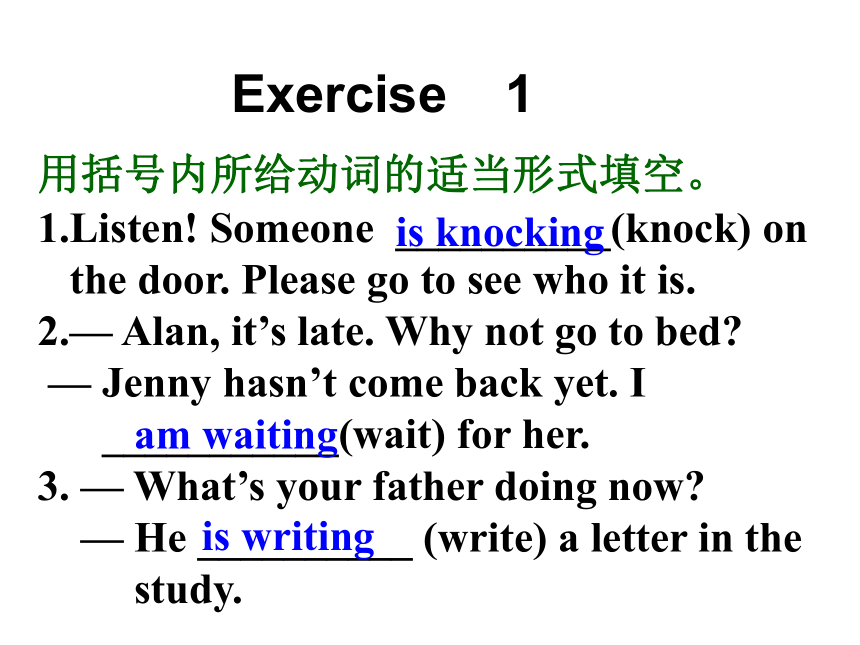
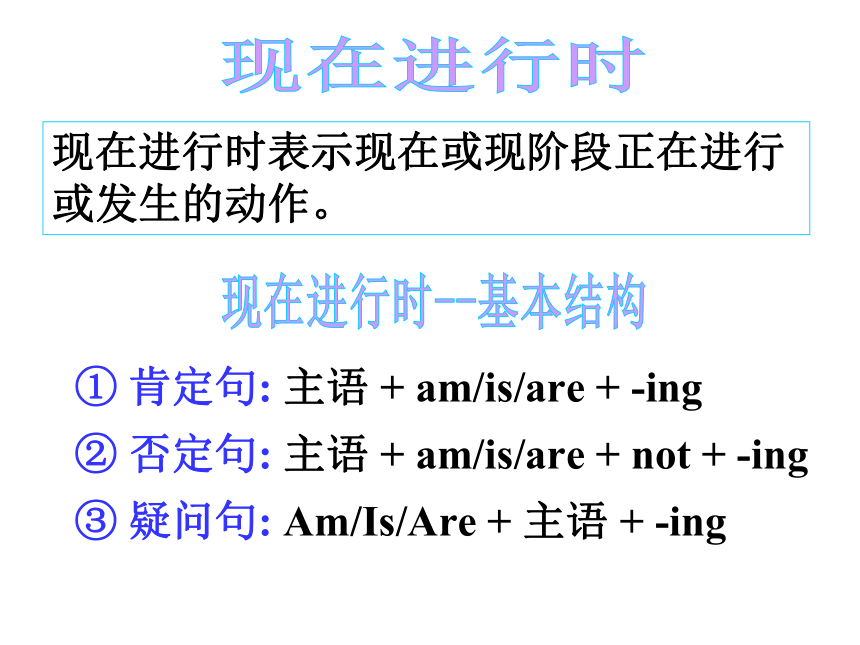

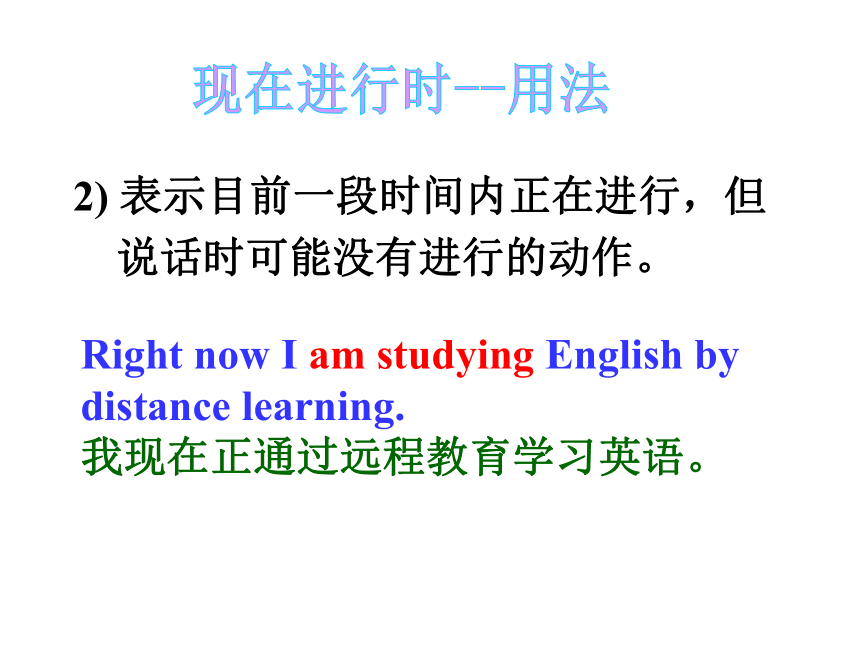
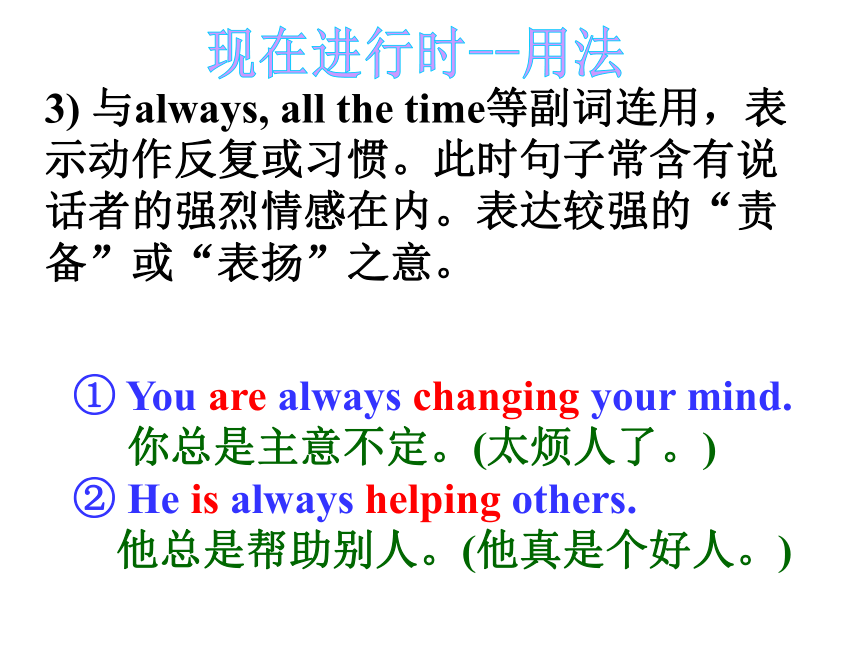
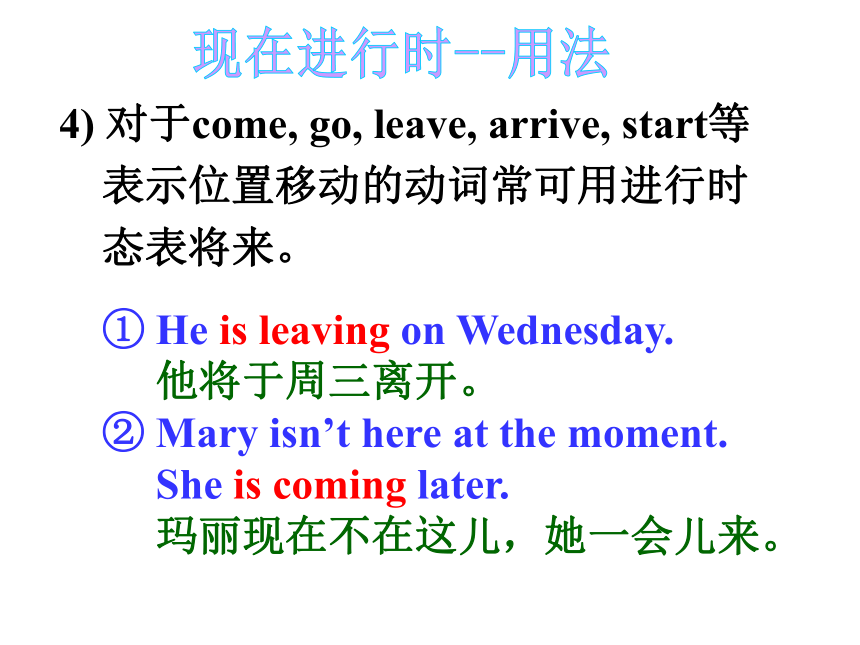
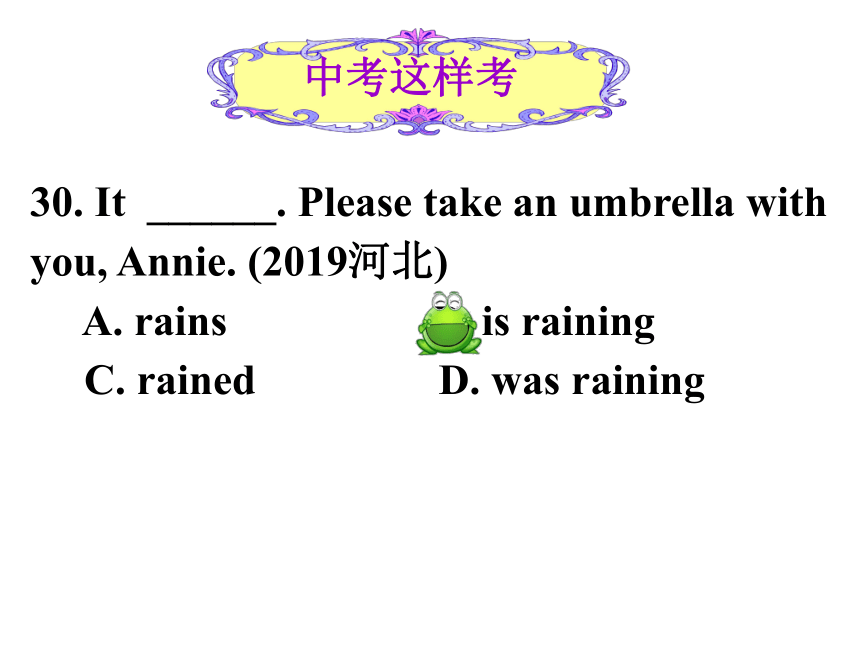

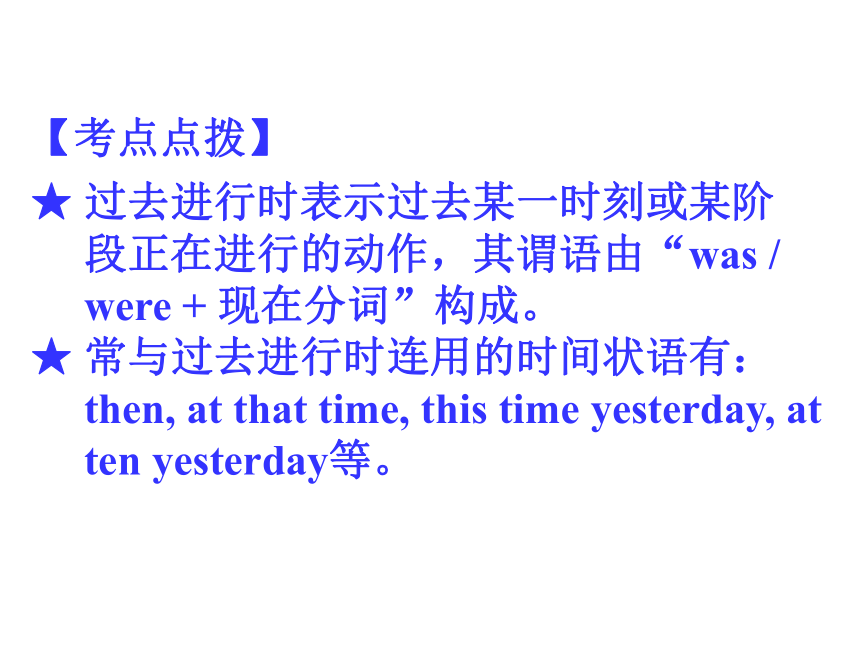

文档简介
(共60张PPT)
Grammar
Focus
1.
We’re
trying
to
save
the
earth.
2.
The
river
used
to
be
so
clean.
3.
The
air
is
badly
polluted.
4.
No
scientific
studies
have
shown
that
shark
fins
are
good
for
health.
5.
We
should
help
save
the
sharks.
Read
the
sentences
by
yourselves.
P100
用括号内所给动词的适当形式填空。
Listen!
Someone
__________(knock)
on
the
door.
Please
go
to
see
who
it
is.
—
Alan,
it’s
late.
Why
not
go
to
bed?
—
Jenny
hasn’t
come
back
yet.
I
___________(wait)
for
her.
3.
—
What’s
your
father
doing
now?
—
He
__________
(write)
a
letter
in
the
study.
is
knocking
am
waiting
is
writing
Exercise
1
①
肯定句:
主语
+
am/is/are
+
-ing
②
否定句:
主语
+
am/is/are
+
not
+
-ing
③
疑问句:
Am/Is/Are
+
主语
+
-ing
现在进行时表示现在或现阶段正在进行或发生的动作。
表示说话时正在进行的,目前正在发生的动作。
①
Look!
The
big
bird
is
flying
away.
看,那只大鸟正在飞走。
②
He
is
watching
a
movie
now.
他现在正在看电影。
2)
表示目前一段时间内正在进行,但
说话时可能没有进行的动作。
Right
now
I
am
studying
English
by
distance
learning.
我现在正通过远程教育学习英语。
3)
与always,
all
the
time等副词连用,表示动作反复或习惯。此时句子常含有说话者的强烈情感在内。表达较强的“责备”或“表扬”之意。
①
You
are
always
changing
your
mind.
你总是主意不定。(太烦人了。)
②
He
is
always
helping
others.
他总是帮助别人。(他真是个好人。)
4)
对于come,
go,
leave,
arrive,
start等
表示位置移动的动词常可用进行时
态表将来。
①
He
is
leaving
on
Wednesday.
他将于周三离开。
②
Mary
isn’t
here
at
the
moment.
She
is
coming
later.
玛丽现在不在这儿,她一会儿来。
30.
It
______.
Please
take
an
umbrella
with
you,
Annie.
(2019河北)
A.
rains
B.
is
raining
C.
rained
D.
was
raining
中考这样考
34.Sorry,
I
didn’t
see
you,
because
I
______.
a
picture.(2019河北)
A.
draw
B.
drew
C.
was
drawing
D.
have
drawn
中考这样考
【考点点拨】
★
过去进行时表示过去某一时刻或某阶
段正在进行的动作,其谓语由“was
/
were
+
现在分词”构成。
★
常与过去进行时连用的时间状语有:
then,
at
that
time,
this
time
yesterday,
at
ten
yesterday等。
31.
Don’t
take
the
dictionary
away.
I
______it.
(2017河北)
A.
use
B.
used
C.
am
using
D.
have
used
中考这样考
用括号内所给动词的适当形式填空。
1.
—
I’d
like
to
introduce
my
best
friend
to
you,
Peter.
—
Thank
you,
Lucy.
But
we
________
(meet)
already.
2.—
Look
at
these
stamps.
I
__________
(keep)
them
for
five
years.
???
—
Wow,
they
are
wonderful.
have
met
have
kept
Exercise
2
肯定句:主语
+
have
/
has
+
过去分词
+
其他
否定句:主语
+
haven’t
/
hasn’t
+
过去分
词
+
其他
一般
Have
/
Has
+
主语
+
过去分词
+
疑问句:…?
肯定答语:Yes,
主格代词
+
have
/
has.
否定答语:No,
主格代词
+
haven’t
/
hasn’t.
1.
表示动作到现在为止已经完成或刚刚完成。
2.
动作发生在过去,强调对现在的结果、
影响等。
3.
表示动作发生在过去,并且一直持续到现
在,甚至还可能继续下去,句中使用持续性
动词,且常有表示一段时间的时间状语。
1)
现在完成时
+
since
+
点时间状语(名词、短语、从句,其中从句用一般过去时)
2)
现在完成时
+
for
+
段时间状语
3)
It
/
This
is
the
first
/
其他序数词
/
last
time
+
that
从句中,从句使用现在完成时。
1)
Mary
has
been
ill
since
three
days
ago.
2)
Mary
has
been
ill
for
three
days.
3)
It
is
the
first
time
that
I
have
visited
the
city.
This
is
the
best
film
that
I’ve
(ever)
seen.
33.
I______an
invitation
to
the
concert.
I
can’t
wait
to
go.(2018河北)
A.
receive
B.
will
receive
C.
was
receiving
D.
have
receiveed
中考这样考
时态
一般现在时
一般过去时
现在进行时
过去进行时
一般将来时
现在完成时
用法
表示经常性发生的动作、习惯性动作或客观真理、科学事实等。
表示过去某个时间发生的动作或存在的状态。
表示现在或现阶段正在进行或发生的动作。
表示过去某时正在进行的动作或存在的状态。
表示将来某个时间要发生的动作或存在的状态。
表示过去发生的事对现在造成的影响或结果。
构成
方式
1.
动词be(am/is/are)
+
表语…
2.
动词原形
+
…
(主语是第三人称单
数,动词也用第三人称单数)
1.
动词was/were
+
表语
2.
实义动词的过
去式
+
…
be(am/is/are)
+
动词的现在分词
was
/
were
+
动词的现在分词
1.
will/shall
+
动词原形
(shall
用于第一人称)
2.
be
going
to
+
动词原形
主语
+
have
/
has
+
过去分词
+
…
句
型
变
化
疑
问
式
1.
Be
+
主语
+
…?
2.
Do/Does
+
主语
+
动词原形+
…?
1.
Was/Were
+
主
语
+
…?
2.
Did
+
主语
+
动词原形
+
…?
Be
+
主语
+
动词的现在分词
+
…?
Was
/
Were
+
主语
+
动词的现在分词
+
…?
1.
Will/Shall
+
主语
+
动词原形+
…?
2.
Be
+
主语+
going
to
+
动词原形
+
…?
Have
/
Has
+
主语
+
过去分词
+
…?
否
定
式
1.
主语
+
be
+
not
+
…
2.
主语+don’t/doesn’t
+
动词原形
+
…
1.
主语
+
was/were
+
not
+…
2.
主语
+
didn’t
+
动词原形
+
…
主语
+
be
+
not
+
动词的现在分词
+
…
主语
+
wasn’t
(was
not)
/
weren’t
(were
not)
+
动词的现在分词
+
…
1.
主语
+
will/shall
not
+
动词原形
+
…
2.
主语
+
be
+
not
+
going
to
+
动词原形
+
…
主语
+
haven’t
/
hasn’t
+
过去分词
+
…
33.
He
______me
his
name,
but
I
can’t
remember
it
now.(2019河北)
A.
tells
B.
will
tell
C.
told
D.
is
telling
中考这样考
用括号内所给动词的适当形式填空。
1.
The
School
Entrance
Exam
_______
(hold)
in
March.
2.
A
strange
noise
__________
(hear)
by
his
mother
last
night.
3.
A
wide
road
_____________
(build)
between
the
two
villages
by
those
people
next
year.
is
held
was
heard
will
be
built
Exercise
3
被动语态表示主语是谓语动作的承受
者,被动语态由“be
+
过去分词”构成。be随着主语人称和数以及时态的不同而变化。
被动语态
1.一般现在时的被动语态:am/is/are
+
过去分词
Thousands
of
trees
are
planted
every
year.
These
computers
were
made
in
our
own
country
last
year.
We
will
be
asked
to
attend
the
opening
ceremony
tomorrow?
2.一般过去时的被动语态:was/were+过去分词
3.一般将来时的被动语态:will+be+过去分词
4.情态动词的被动语态:情态动词+be+过去分词
To
protect
the
environment,
the
old
books
and
newspapers
should
be
recycled.
(1)在使役动词have,
make,
get以及感官动词see,
watch,
notice,
hear,
feel,
observe等后面不定式作宾语补语时,在主动结构中不定式to要省略,但变为被动结构时,要加
to。
They
make
her
clean
the
floor.
?
She
is
made
to
clean
the
floor
by
them.
特殊的被动语态
(2)动词短语变为被动语态时,动词短语后面的介词或副词不能省略。
eg:The
baby
was
looked
after
by
her
sister.
这婴儿由她的姐姐照顾。
1.
某些感官动词加形容词及少数其他的动词本身可以表示被动意义。
smell,
taste,
prove,
sell,
etc.
1)
The
dish
tastes
delicious.
2)
The
theory
proved
right
at
last.
3)
The
book
is
so
interesting
that
it
sells
well.
不可以变成被动语态的情况
need
+
V-
ing/to
be
done
表示“需要(被)…”,表示被动意义。
我的车需要修理。
My
car
needs
repairing.
(=
to
be
repaired).
The
new
book
came
out
last
month.
但不能说:The
new
book
was
come
out.
3.
通常只有及物动词(组)才有被动语态,不及物动词没有。
32.
These
cakes
______with
chocolate.
Have
one,
please.(2019河北)
A.
fill
B.
filled
C.
are
filled
D.
were
filled
中考这样考
34.
Look
at
the
picture.
The
top
five
TV
plays
______in
it.(2018河北)
A.
list
B.
are
listed
C.
will
list
D.
will
be
listed
中考这样考
35.
Hangzhou
______as
the
City
of
Silk.
Tourists
like
shopping
for
silk
there.(2017河北)
A.
knows
B.
is
known
C.
was
known
D.
will
be
known
中考这样考
We
can
do
it
by
ourselves.
It
must
be
Tom’s.
Look
at
his
name
on
the
cover.
3.I’m
sorry.
Children
mustn’t
swim
here.
4.May
I
see
you
ID
card,
sir?
5.Will
you
pass
me
the
book?
指出下列划线动词的种类。
情态动词
情态动词
情态动词
情态动词
Exercise
4
情态动词具有一定的意义,但不能单独作谓语,其后需接动词原形一起构成句子的谓语。情态动词(除have
to以外)没有人称和数的变化。另外,情态动词可用来构成否定句、疑问句并进行简略回答。初中常见的情态动词有:can,
may,
must,
need,
have
to,
could,
should,
ought
to
等。
考点一:考查表示“能力”的情态动词
1.
—
________
your
Australian
friend
eat
with
chopsticks?
—
Yes,
but
she
can’t
use
them
well.
A.
Should
B.
Need
C.
Can
D.
Must
2.
The
work
is
too
hard
for
us.
We
_______
finish
it
on
time.
A.
can’t
B.
mustn’t
C.
shouldn’t
D.
needn’t
3.
—
Could
your
father
play
golf
when
he
was
young?
—
No,
he
________.
But
he
________
play
table
tennis.
A.
couldn’t;
could
B.
needn’t;
might
C.
mustn’t;
should
D.
shouldn’t;
need
【考点点拨】
★情态动词can表示“能力”时,与be
able
to同义,其否定形式为can’t。can表示现在的能力,其过去式could表示过去的能力。
考点二:考查表示“应该”的情态动词
1.
—
________
we
to
finish
our
homework
before
noon?
—
Yes,
you
________.
A.
Need;
can
B.
Have;
do
C.
Ought;
ought
to
D.
Should;
must
2.
You
________
study
hard
if
you
want
to
be
a
scientist
in
the
future.
A.
may
B.
should
C.
would
D.
could
【考点点拨】
★情态动词should和ought
to都可表示
“应该”,但should侧重说话者主观的看法,而ought
to更侧重客观情况。
★should的否定形式为shouldn’t,ought
to的否定形式为oughtn’t
to或ought
not
to。
考点三:考查表示“请求;许可”的情态动词及其回答
1.
—
________
I
borrow
your
maths
book?
—
Sure.
Here
you
are.
A.
Need
B.
Will
C.
May
D.
Must
2.
—
________
I
take
some
photos
in
the
hall?
—
No,
you
________.
Look
at
the
sign
“No
photos”!
A.
Can;
needn’t
B.
Must;
mustn’t
C.
Should;
needn’t
D.
May;
mustn’t
3.
—
Could
I
use
your
dictionary
for
a
while?
—
Yes,
of
course
you
________.
A.
could
B.
can
C.
will
D.
should
【考点点拨】
★情态动词may和can都可表示“请求;
许可”。may比can正式,could在表示“请求;许可”
时,既可表示过去,也可表示语气的委婉。
★当“May
/
Can
/
Could
I
…”表示“请求;许可”时,肯定回答常用“Yes,
please.”
/
“Certainly.”等,否定回答常用“No,
you
can’t
/
mustn’t.”等。
考点四:考查表示“推测”的情态动词
1.
—
I
saw
Lily
in
the
supermarket
this
morning.
—
Oh,
it
________
her.
She
moved
to
Australia
the
day
before
yesterday.
A.
can
be
B.
must
be
C.
can’t
be
D.
mustn’t
be
2.
After
a
long
walk,
the
children
________
be
very
tired
now.
A.
will
B.
must
C.
have
to
D.
can
3.
John
________
go
with
us
tomorrow,
but
he
isn’t
sure.
A.
must
B.
can
C.
need
D.
may
【考点点拨】
★may,
can,
must都可表“推测”,三者
的可能性依次递增。
★may和must表“推测”常用于肯定句
中,can表“推测”常用于否定句和疑问句中。
考点五:考查need,
must和have
to的用法
1.
Jim,
you
________
play
with
the
knife.
You
________
hurt
yourself.
A.
won’t;
can’t
B.
mustn’t;
may
C.
shouldn’t;
must
D.
can’t;
shouldn’t
2.
—
________
I
have
to
hand
in
my
homework
now,
Mr
Zhang?
—
Yes,
you
do.
A.
Do
B.
Can
C.
May
D.
Must
3.
—
Must
I
get
up
before
six
o’clock
tomorrow
morning,
Dad?
—
No,
you
________.
Tomorrow
is
Saturday.
You
may
get
up
a
little
later.
A.
mustn’t
B.
can’t
C.
needn’t
D.
may
not
4.
It’s
too
late.
We
________
go
home,
or
we’ll
be
blamed
(责备).
A.
can
B.
may
C.
might
D.
have
to
【考点点拨】
★need作情态动词,意为“需要”,后接动词原形,常用于否定句、疑问句和条件句中。
★must意为“必须”,强调主观看法。
对must引导的一般疑问句,肯定回答常用“must”,否定回答常用needn’t或don’t
have
to。mustn’t意为“一定不要;禁止”。
★have
to意为“
不得不;必须”,强调
客观情况下需要做某事,有人称、数和时态的变化,变否定句和疑问句时需要借助助动词完成句型的变化。
分类
特点
例词
意义
例句
情态动词
跟动词原形(有自己的词汇意思)
can
(could),
may
(might),
should,
ought
to,
must,
need,
have
to,
etc.
不能独立做谓语。表示说话人语气、情感或态度,无人称和数的变化(have
to除外)
We
can’t
carry
the
heavy
box.
He
may
come
tomorrow.
We
must
study
hard.
30.
I
have
travelled
a
lot.
I
______speak
four
languages.(2017河北)
A.
can
B.
may
C.
must
D.
need
中考这样考
Jenny
used
to
play
the
piano.
用used
to句型说出与图片情景相符的句子。
Jenny
Mike
used
to
wear
glasses.
Mike,
glasses
Peter
used
to
play
soccer.
Peter,
soccer
Amy,
long
hair
Amy
used
to
have
long
hair.
Mark
used
to
like
swimming.
Mark,
like
swim
used
to
“__________”,
表示___________
used
to
+
___________
对比现在和过去:
_____________________
____________________________________
过去的习惯
过去常常
动词原形
but
not
any
more,
but
not
any
longer
but
now
…,
翻译下列句子。
艾米以前是短头发吗?
你以前常在学校吃午餐吗?
他过去不戴眼镜。
这些商店过去在周日是不营业的。
他以前很高,是吗?
Did
Amy
use
to
have
short
hair?
Did
you
use
to
have
lunch
at
school?
He
didn’t
use
to
wear
glasses.
The
shop
usedn’t
to
open
on
Sundays.
He
used
to
be
very
tall,
didn’t
he?
used
to
的否定句和疑问句
否定句:
didn’t
use
to
…
/used
not
to
…
一般疑问句:
Did
you
use
to...?
/Used
you
to
…?
变反意疑问句,附加疑问部分可用didn’t
/usedn’t
或did
/
used
She
used
not
to
like
tests.
Used
you
to
be
popular
in
school?
They
usedn’t
to
go
skating,
did
they?
定义
used
to
“过去常常”,
表过去的习惯
used
to
+
动词原形
对比现在和过去:
but
now
…,but
not
any
more,
but
not
any
longer
句式
否定句:
didn’t
use
to
…
/used
not
to
…
一般疑问句:
Did
you
use
to...?
/Used
you
to
…?
变反意疑问句,附加疑问部分可用
didn’t
/usedn’t
或did
/
used
used
to
Finish
the
exercises
4a-4c
on
page
100.
Find
the
answer
to
the
question.
4a
Fill
in
the
blanks
with
the
correct
forms
of
the
verbs
in
brackets.
Joe:
_____
you
ever
______
(take)
part
in
an
environmental
project
?
Eric:
Yes,
I
have.
I
______
(help)
with
a
Clean-Up
Day
last
year.
It
was
__________
(consider)
the
biggest
clean-up
project
this
city
____
ever
____
(have).
Have
taken
helped
considered
had
had
参加
Joe:
How
many
people
____
(take)
part?
Eric:
I
_____
(think)
more
than
1,000
people
______
(come)
to
help
out.
Joe:
That’s
fantastic!
I
guess
everyone
in
this
city
is
______
(try)
to
improve
the
environment.
Eric:
Yes,
we
can’t
afford
to
____
(wait)
any
longer
to
take
action!
took
think
came
trying
wait
v.
承担得起(后果);
买得起
afford
to
do
sth.
We
can’t
afford
to
buy
another
house.
4b
Fill
in
the
blanks
with
the
appropriate
modal
verbs
from
the
box.
People
__________
think
that
big
things
______
be
done
to
save
the
earth.
Many
forget
that
saving
the
earth
begins
with
small
things.
For
example,
you
____
save
may/might
must/should/have
to
can/could/should
can
would
could
have
to
should
must
may/
might
electricity
by
turning
off
the
lights
when
you
leave
a
room.
You
______
also
use
reusable
bags
instead
of
plastic
bags.
I
think
it’s
a
great
idea
that
you
now
______
pay
for
plastic
bags
in
some
stores.
And
instead
of
driving
to
school
or
work,
you
__________
ride
your
bike
or
walk.
If
it’s
far,
you
__________
take
the
bus.
All
these
can/could/should
have
to
can/could/should
can/could
关掉
adj.可重复使用的
付费;付出代价
small
things
______
add
up
and
become
big
things
that
_________
improve
the
environment.
Let’s
take
action
now!
can/could
would/can/could
采取行动
4c
Make
a
list
of
things
that
people
can
do
to
help
the
environment
and
discuss
your
list
with
your
partner.
use
public
transportation
(n.交通运输);
turn
off
the
lights
when
you
leave
a
room;
use
reusable
bags
instead
of
plastic
bags;
ride
your
bike
or
walk
to
school
or
work;
stop
using
paper
napkins(餐巾纸);
recycle
books
and
paper
…
I
think
that
everyone
should
use
public
transportation.
I
disagree.
It’s
difficult
for
parents
with
young
children
to
use
public
transportation…
1.
复习今天讲到的语法内容。
2.
预习(preview)
2b
大课文
P102,
完成P102表格.
Grammar
Focus
1.
We’re
trying
to
save
the
earth.
2.
The
river
used
to
be
so
clean.
3.
The
air
is
badly
polluted.
4.
No
scientific
studies
have
shown
that
shark
fins
are
good
for
health.
5.
We
should
help
save
the
sharks.
Read
the
sentences
by
yourselves.
P100
用括号内所给动词的适当形式填空。
Listen!
Someone
__________(knock)
on
the
door.
Please
go
to
see
who
it
is.
—
Alan,
it’s
late.
Why
not
go
to
bed?
—
Jenny
hasn’t
come
back
yet.
I
___________(wait)
for
her.
3.
—
What’s
your
father
doing
now?
—
He
__________
(write)
a
letter
in
the
study.
is
knocking
am
waiting
is
writing
Exercise
1
①
肯定句:
主语
+
am/is/are
+
-ing
②
否定句:
主语
+
am/is/are
+
not
+
-ing
③
疑问句:
Am/Is/Are
+
主语
+
-ing
现在进行时表示现在或现阶段正在进行或发生的动作。
表示说话时正在进行的,目前正在发生的动作。
①
Look!
The
big
bird
is
flying
away.
看,那只大鸟正在飞走。
②
He
is
watching
a
movie
now.
他现在正在看电影。
2)
表示目前一段时间内正在进行,但
说话时可能没有进行的动作。
Right
now
I
am
studying
English
by
distance
learning.
我现在正通过远程教育学习英语。
3)
与always,
all
the
time等副词连用,表示动作反复或习惯。此时句子常含有说话者的强烈情感在内。表达较强的“责备”或“表扬”之意。
①
You
are
always
changing
your
mind.
你总是主意不定。(太烦人了。)
②
He
is
always
helping
others.
他总是帮助别人。(他真是个好人。)
4)
对于come,
go,
leave,
arrive,
start等
表示位置移动的动词常可用进行时
态表将来。
①
He
is
leaving
on
Wednesday.
他将于周三离开。
②
Mary
isn’t
here
at
the
moment.
She
is
coming
later.
玛丽现在不在这儿,她一会儿来。
30.
It
______.
Please
take
an
umbrella
with
you,
Annie.
(2019河北)
A.
rains
B.
is
raining
C.
rained
D.
was
raining
中考这样考
34.Sorry,
I
didn’t
see
you,
because
I
______.
a
picture.(2019河北)
A.
draw
B.
drew
C.
was
drawing
D.
have
drawn
中考这样考
【考点点拨】
★
过去进行时表示过去某一时刻或某阶
段正在进行的动作,其谓语由“was
/
were
+
现在分词”构成。
★
常与过去进行时连用的时间状语有:
then,
at
that
time,
this
time
yesterday,
at
ten
yesterday等。
31.
Don’t
take
the
dictionary
away.
I
______it.
(2017河北)
A.
use
B.
used
C.
am
using
D.
have
used
中考这样考
用括号内所给动词的适当形式填空。
1.
—
I’d
like
to
introduce
my
best
friend
to
you,
Peter.
—
Thank
you,
Lucy.
But
we
________
(meet)
already.
2.—
Look
at
these
stamps.
I
__________
(keep)
them
for
five
years.
???
—
Wow,
they
are
wonderful.
have
met
have
kept
Exercise
2
肯定句:主语
+
have
/
has
+
过去分词
+
其他
否定句:主语
+
haven’t
/
hasn’t
+
过去分
词
+
其他
一般
Have
/
Has
+
主语
+
过去分词
+
疑问句:…?
肯定答语:Yes,
主格代词
+
have
/
has.
否定答语:No,
主格代词
+
haven’t
/
hasn’t.
1.
表示动作到现在为止已经完成或刚刚完成。
2.
动作发生在过去,强调对现在的结果、
影响等。
3.
表示动作发生在过去,并且一直持续到现
在,甚至还可能继续下去,句中使用持续性
动词,且常有表示一段时间的时间状语。
1)
现在完成时
+
since
+
点时间状语(名词、短语、从句,其中从句用一般过去时)
2)
现在完成时
+
for
+
段时间状语
3)
It
/
This
is
the
first
/
其他序数词
/
last
time
+
that
从句中,从句使用现在完成时。
1)
Mary
has
been
ill
since
three
days
ago.
2)
Mary
has
been
ill
for
three
days.
3)
It
is
the
first
time
that
I
have
visited
the
city.
This
is
the
best
film
that
I’ve
(ever)
seen.
33.
I______an
invitation
to
the
concert.
I
can’t
wait
to
go.(2018河北)
A.
receive
B.
will
receive
C.
was
receiving
D.
have
receiveed
中考这样考
时态
一般现在时
一般过去时
现在进行时
过去进行时
一般将来时
现在完成时
用法
表示经常性发生的动作、习惯性动作或客观真理、科学事实等。
表示过去某个时间发生的动作或存在的状态。
表示现在或现阶段正在进行或发生的动作。
表示过去某时正在进行的动作或存在的状态。
表示将来某个时间要发生的动作或存在的状态。
表示过去发生的事对现在造成的影响或结果。
构成
方式
1.
动词be(am/is/are)
+
表语…
2.
动词原形
+
…
(主语是第三人称单
数,动词也用第三人称单数)
1.
动词was/were
+
表语
2.
实义动词的过
去式
+
…
be(am/is/are)
+
动词的现在分词
was
/
were
+
动词的现在分词
1.
will/shall
+
动词原形
(shall
用于第一人称)
2.
be
going
to
+
动词原形
主语
+
have
/
has
+
过去分词
+
…
句
型
变
化
疑
问
式
1.
Be
+
主语
+
…?
2.
Do/Does
+
主语
+
动词原形+
…?
1.
Was/Were
+
主
语
+
…?
2.
Did
+
主语
+
动词原形
+
…?
Be
+
主语
+
动词的现在分词
+
…?
Was
/
Were
+
主语
+
动词的现在分词
+
…?
1.
Will/Shall
+
主语
+
动词原形+
…?
2.
Be
+
主语+
going
to
+
动词原形
+
…?
Have
/
Has
+
主语
+
过去分词
+
…?
否
定
式
1.
主语
+
be
+
not
+
…
2.
主语+don’t/doesn’t
+
动词原形
+
…
1.
主语
+
was/were
+
not
+…
2.
主语
+
didn’t
+
动词原形
+
…
主语
+
be
+
not
+
动词的现在分词
+
…
主语
+
wasn’t
(was
not)
/
weren’t
(were
not)
+
动词的现在分词
+
…
1.
主语
+
will/shall
not
+
动词原形
+
…
2.
主语
+
be
+
not
+
going
to
+
动词原形
+
…
主语
+
haven’t
/
hasn’t
+
过去分词
+
…
33.
He
______me
his
name,
but
I
can’t
remember
it
now.(2019河北)
A.
tells
B.
will
tell
C.
told
D.
is
telling
中考这样考
用括号内所给动词的适当形式填空。
1.
The
School
Entrance
Exam
_______
(hold)
in
March.
2.
A
strange
noise
__________
(hear)
by
his
mother
last
night.
3.
A
wide
road
_____________
(build)
between
the
two
villages
by
those
people
next
year.
is
held
was
heard
will
be
built
Exercise
3
被动语态表示主语是谓语动作的承受
者,被动语态由“be
+
过去分词”构成。be随着主语人称和数以及时态的不同而变化。
被动语态
1.一般现在时的被动语态:am/is/are
+
过去分词
Thousands
of
trees
are
planted
every
year.
These
computers
were
made
in
our
own
country
last
year.
We
will
be
asked
to
attend
the
opening
ceremony
tomorrow?
2.一般过去时的被动语态:was/were+过去分词
3.一般将来时的被动语态:will+be+过去分词
4.情态动词的被动语态:情态动词+be+过去分词
To
protect
the
environment,
the
old
books
and
newspapers
should
be
recycled.
(1)在使役动词have,
make,
get以及感官动词see,
watch,
notice,
hear,
feel,
observe等后面不定式作宾语补语时,在主动结构中不定式to要省略,但变为被动结构时,要加
to。
They
make
her
clean
the
floor.
?
She
is
made
to
clean
the
floor
by
them.
特殊的被动语态
(2)动词短语变为被动语态时,动词短语后面的介词或副词不能省略。
eg:The
baby
was
looked
after
by
her
sister.
这婴儿由她的姐姐照顾。
1.
某些感官动词加形容词及少数其他的动词本身可以表示被动意义。
smell,
taste,
prove,
sell,
etc.
1)
The
dish
tastes
delicious.
2)
The
theory
proved
right
at
last.
3)
The
book
is
so
interesting
that
it
sells
well.
不可以变成被动语态的情况
need
+
V-
ing/to
be
done
表示“需要(被)…”,表示被动意义。
我的车需要修理。
My
car
needs
repairing.
(=
to
be
repaired).
The
new
book
came
out
last
month.
但不能说:The
new
book
was
come
out.
3.
通常只有及物动词(组)才有被动语态,不及物动词没有。
32.
These
cakes
______with
chocolate.
Have
one,
please.(2019河北)
A.
fill
B.
filled
C.
are
filled
D.
were
filled
中考这样考
34.
Look
at
the
picture.
The
top
five
TV
plays
______in
it.(2018河北)
A.
list
B.
are
listed
C.
will
list
D.
will
be
listed
中考这样考
35.
Hangzhou
______as
the
City
of
Silk.
Tourists
like
shopping
for
silk
there.(2017河北)
A.
knows
B.
is
known
C.
was
known
D.
will
be
known
中考这样考
We
can
do
it
by
ourselves.
It
must
be
Tom’s.
Look
at
his
name
on
the
cover.
3.I’m
sorry.
Children
mustn’t
swim
here.
4.May
I
see
you
ID
card,
sir?
5.Will
you
pass
me
the
book?
指出下列划线动词的种类。
情态动词
情态动词
情态动词
情态动词
Exercise
4
情态动词具有一定的意义,但不能单独作谓语,其后需接动词原形一起构成句子的谓语。情态动词(除have
to以外)没有人称和数的变化。另外,情态动词可用来构成否定句、疑问句并进行简略回答。初中常见的情态动词有:can,
may,
must,
need,
have
to,
could,
should,
ought
to
等。
考点一:考查表示“能力”的情态动词
1.
—
________
your
Australian
friend
eat
with
chopsticks?
—
Yes,
but
she
can’t
use
them
well.
A.
Should
B.
Need
C.
Can
D.
Must
2.
The
work
is
too
hard
for
us.
We
_______
finish
it
on
time.
A.
can’t
B.
mustn’t
C.
shouldn’t
D.
needn’t
3.
—
Could
your
father
play
golf
when
he
was
young?
—
No,
he
________.
But
he
________
play
table
tennis.
A.
couldn’t;
could
B.
needn’t;
might
C.
mustn’t;
should
D.
shouldn’t;
need
【考点点拨】
★情态动词can表示“能力”时,与be
able
to同义,其否定形式为can’t。can表示现在的能力,其过去式could表示过去的能力。
考点二:考查表示“应该”的情态动词
1.
—
________
we
to
finish
our
homework
before
noon?
—
Yes,
you
________.
A.
Need;
can
B.
Have;
do
C.
Ought;
ought
to
D.
Should;
must
2.
You
________
study
hard
if
you
want
to
be
a
scientist
in
the
future.
A.
may
B.
should
C.
would
D.
could
【考点点拨】
★情态动词should和ought
to都可表示
“应该”,但should侧重说话者主观的看法,而ought
to更侧重客观情况。
★should的否定形式为shouldn’t,ought
to的否定形式为oughtn’t
to或ought
not
to。
考点三:考查表示“请求;许可”的情态动词及其回答
1.
—
________
I
borrow
your
maths
book?
—
Sure.
Here
you
are.
A.
Need
B.
Will
C.
May
D.
Must
2.
—
________
I
take
some
photos
in
the
hall?
—
No,
you
________.
Look
at
the
sign
“No
photos”!
A.
Can;
needn’t
B.
Must;
mustn’t
C.
Should;
needn’t
D.
May;
mustn’t
3.
—
Could
I
use
your
dictionary
for
a
while?
—
Yes,
of
course
you
________.
A.
could
B.
can
C.
will
D.
should
【考点点拨】
★情态动词may和can都可表示“请求;
许可”。may比can正式,could在表示“请求;许可”
时,既可表示过去,也可表示语气的委婉。
★当“May
/
Can
/
Could
I
…”表示“请求;许可”时,肯定回答常用“Yes,
please.”
/
“Certainly.”等,否定回答常用“No,
you
can’t
/
mustn’t.”等。
考点四:考查表示“推测”的情态动词
1.
—
I
saw
Lily
in
the
supermarket
this
morning.
—
Oh,
it
________
her.
She
moved
to
Australia
the
day
before
yesterday.
A.
can
be
B.
must
be
C.
can’t
be
D.
mustn’t
be
2.
After
a
long
walk,
the
children
________
be
very
tired
now.
A.
will
B.
must
C.
have
to
D.
can
3.
John
________
go
with
us
tomorrow,
but
he
isn’t
sure.
A.
must
B.
can
C.
need
D.
may
【考点点拨】
★may,
can,
must都可表“推测”,三者
的可能性依次递增。
★may和must表“推测”常用于肯定句
中,can表“推测”常用于否定句和疑问句中。
考点五:考查need,
must和have
to的用法
1.
Jim,
you
________
play
with
the
knife.
You
________
hurt
yourself.
A.
won’t;
can’t
B.
mustn’t;
may
C.
shouldn’t;
must
D.
can’t;
shouldn’t
2.
—
________
I
have
to
hand
in
my
homework
now,
Mr
Zhang?
—
Yes,
you
do.
A.
Do
B.
Can
C.
May
D.
Must
3.
—
Must
I
get
up
before
six
o’clock
tomorrow
morning,
Dad?
—
No,
you
________.
Tomorrow
is
Saturday.
You
may
get
up
a
little
later.
A.
mustn’t
B.
can’t
C.
needn’t
D.
may
not
4.
It’s
too
late.
We
________
go
home,
or
we’ll
be
blamed
(责备).
A.
can
B.
may
C.
might
D.
have
to
【考点点拨】
★need作情态动词,意为“需要”,后接动词原形,常用于否定句、疑问句和条件句中。
★must意为“必须”,强调主观看法。
对must引导的一般疑问句,肯定回答常用“must”,否定回答常用needn’t或don’t
have
to。mustn’t意为“一定不要;禁止”。
★have
to意为“
不得不;必须”,强调
客观情况下需要做某事,有人称、数和时态的变化,变否定句和疑问句时需要借助助动词完成句型的变化。
分类
特点
例词
意义
例句
情态动词
跟动词原形(有自己的词汇意思)
can
(could),
may
(might),
should,
ought
to,
must,
need,
have
to,
etc.
不能独立做谓语。表示说话人语气、情感或态度,无人称和数的变化(have
to除外)
We
can’t
carry
the
heavy
box.
He
may
come
tomorrow.
We
must
study
hard.
30.
I
have
travelled
a
lot.
I
______speak
four
languages.(2017河北)
A.
can
B.
may
C.
must
D.
need
中考这样考
Jenny
used
to
play
the
piano.
用used
to句型说出与图片情景相符的句子。
Jenny
Mike
used
to
wear
glasses.
Mike,
glasses
Peter
used
to
play
soccer.
Peter,
soccer
Amy,
long
hair
Amy
used
to
have
long
hair.
Mark
used
to
like
swimming.
Mark,
like
swim
used
to
“__________”,
表示___________
used
to
+
___________
对比现在和过去:
_____________________
____________________________________
过去的习惯
过去常常
动词原形
but
not
any
more,
but
not
any
longer
but
now
…,
翻译下列句子。
艾米以前是短头发吗?
你以前常在学校吃午餐吗?
他过去不戴眼镜。
这些商店过去在周日是不营业的。
他以前很高,是吗?
Did
Amy
use
to
have
short
hair?
Did
you
use
to
have
lunch
at
school?
He
didn’t
use
to
wear
glasses.
The
shop
usedn’t
to
open
on
Sundays.
He
used
to
be
very
tall,
didn’t
he?
used
to
的否定句和疑问句
否定句:
didn’t
use
to
…
/used
not
to
…
一般疑问句:
Did
you
use
to...?
/Used
you
to
…?
变反意疑问句,附加疑问部分可用didn’t
/usedn’t
或did
/
used
She
used
not
to
like
tests.
Used
you
to
be
popular
in
school?
They
usedn’t
to
go
skating,
did
they?
定义
used
to
“过去常常”,
表过去的习惯
used
to
+
动词原形
对比现在和过去:
but
now
…,but
not
any
more,
but
not
any
longer
句式
否定句:
didn’t
use
to
…
/used
not
to
…
一般疑问句:
Did
you
use
to...?
/Used
you
to
…?
变反意疑问句,附加疑问部分可用
didn’t
/usedn’t
或did
/
used
used
to
Finish
the
exercises
4a-4c
on
page
100.
Find
the
answer
to
the
question.
4a
Fill
in
the
blanks
with
the
correct
forms
of
the
verbs
in
brackets.
Joe:
_____
you
ever
______
(take)
part
in
an
environmental
project
?
Eric:
Yes,
I
have.
I
______
(help)
with
a
Clean-Up
Day
last
year.
It
was
__________
(consider)
the
biggest
clean-up
project
this
city
____
ever
____
(have).
Have
taken
helped
considered
had
had
参加
Joe:
How
many
people
____
(take)
part?
Eric:
I
_____
(think)
more
than
1,000
people
______
(come)
to
help
out.
Joe:
That’s
fantastic!
I
guess
everyone
in
this
city
is
______
(try)
to
improve
the
environment.
Eric:
Yes,
we
can’t
afford
to
____
(wait)
any
longer
to
take
action!
took
think
came
trying
wait
v.
承担得起(后果);
买得起
afford
to
do
sth.
We
can’t
afford
to
buy
another
house.
4b
Fill
in
the
blanks
with
the
appropriate
modal
verbs
from
the
box.
People
__________
think
that
big
things
______
be
done
to
save
the
earth.
Many
forget
that
saving
the
earth
begins
with
small
things.
For
example,
you
____
save
may/might
must/should/have
to
can/could/should
can
would
could
have
to
should
must
may/
might
electricity
by
turning
off
the
lights
when
you
leave
a
room.
You
______
also
use
reusable
bags
instead
of
plastic
bags.
I
think
it’s
a
great
idea
that
you
now
______
pay
for
plastic
bags
in
some
stores.
And
instead
of
driving
to
school
or
work,
you
__________
ride
your
bike
or
walk.
If
it’s
far,
you
__________
take
the
bus.
All
these
can/could/should
have
to
can/could/should
can/could
关掉
adj.可重复使用的
付费;付出代价
small
things
______
add
up
and
become
big
things
that
_________
improve
the
environment.
Let’s
take
action
now!
can/could
would/can/could
采取行动
4c
Make
a
list
of
things
that
people
can
do
to
help
the
environment
and
discuss
your
list
with
your
partner.
use
public
transportation
(n.交通运输);
turn
off
the
lights
when
you
leave
a
room;
use
reusable
bags
instead
of
plastic
bags;
ride
your
bike
or
walk
to
school
or
work;
stop
using
paper
napkins(餐巾纸);
recycle
books
and
paper
…
I
think
that
everyone
should
use
public
transportation.
I
disagree.
It’s
difficult
for
parents
with
young
children
to
use
public
transportation…
1.
复习今天讲到的语法内容。
2.
预习(preview)
2b
大课文
P102,
完成P102表格.
同课章节目录
- Unit 1 How can we become good learners.
- Section A
- Section B
- Unit 2 I think that mooncakes are delicious!
- Section A
- Section B
- Unit 3 Could you please tell me where the restroom
- Section A
- Section B
- Unit 4 I used to be afraid of the dark.
- Section A
- Section B
- Unit 5 What are the shirts made of?
- Section A
- Section B
- Review of Units 1-5
- Unit 6 When was it invented?
- Section A
- Section B
- Unit 7 Teenagers should be allowed to choose their
- Section A
- Section B
- Unit 8 It must belong to Carla.
- Section A
- Section B
- Unit 9 I like music that I can dance to.
- Section A
- Section B
- Unit 10 You're supposed to shake hands.
- Section A
- Section B
- Review of Units 6-10
- Unit 11 Sad movies make me cry.
- Section A
- Section B
- Unit 12 Life is full of the unexpected
- Section A
- Section B
- Unit 13 We're trying to save the earth!
- Section A
- Section B
- Unit 14 I remember meeting all of you in Grade 7.
- Section A
- Section B
- Review of Units 11-14
